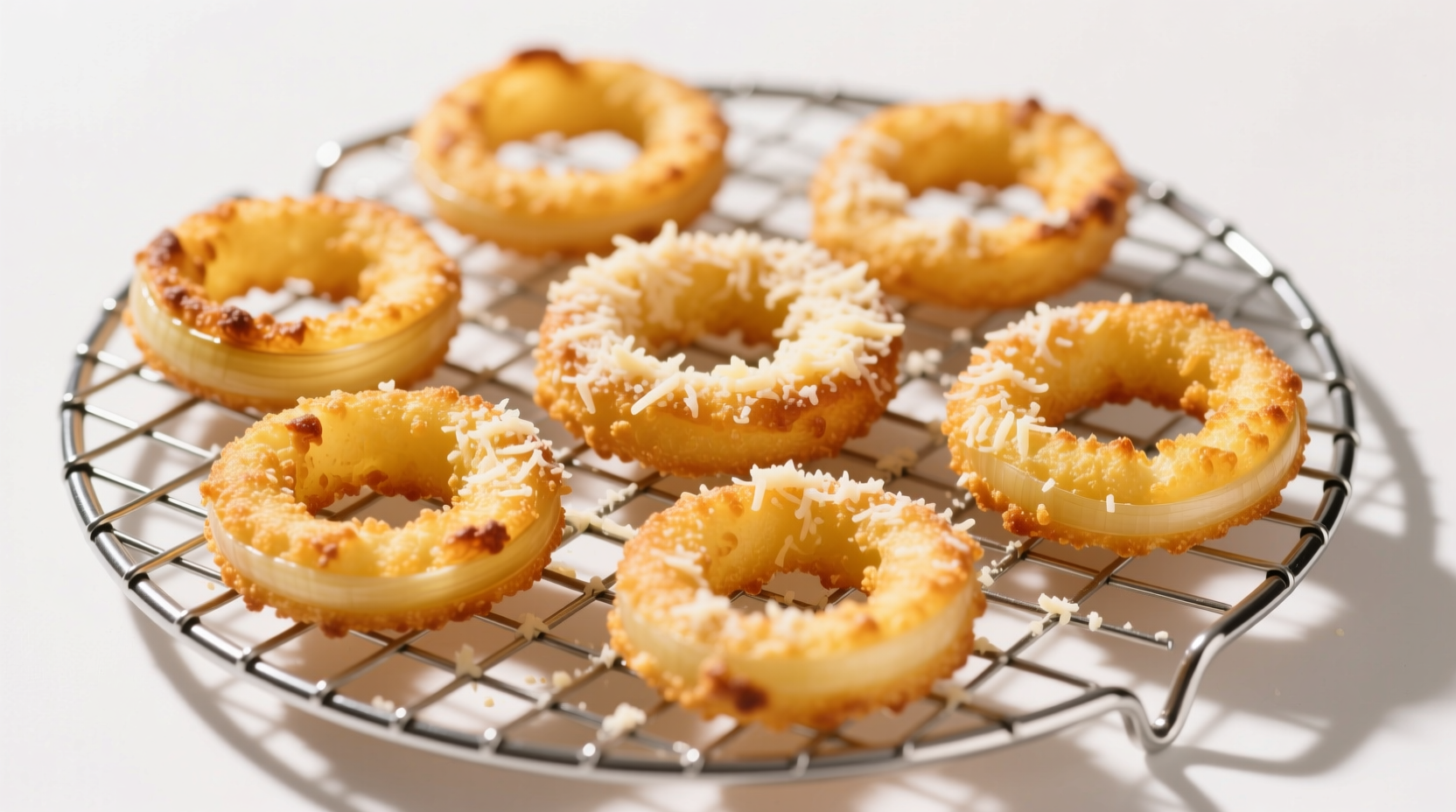The Science Behind Perfect Parmesan Onion Rings
Unlike standard onion rings, parmesan onion rings incorporate finely grated parmesan cheese into the batter, creating a flavor transformation that's both nutty and umami-rich. Food science reveals that parmesan's low moisture content (only 32% water compared to 85% in fresh mozzarella) prevents batter sogginess while its natural glutamates enhance overall flavor perception. According to culinary research from the Culinary Institute of America, the ideal parmesan-to-flour ratio is 1:4—any more cheese compromises structural integrity during frying.
| Characteristic | Traditional Onion Rings | Parmesan Onion Rings |
|---|---|---|
| Batter Composition | Flour, egg, breadcrumbs | Flour, egg, parmesan, breadcrumbs |
| Crispiness Duration | 10-15 minutes before softening | 25-30 minutes maintaining crispness |
| Flavor Profile | Neutral, primarily onion flavor | Complex umami with nutty undertones |
| Oil Absorption | 18-22% of batter weight | 12-15% of batter weight |
Why Onion Selection Matters More Than You Think
Vidalia and Walla Walla sweet onions contain 4-5% sugar content—nearly double that of yellow onions—creating caramelization that balances parmesan's saltiness. However, their high water content (90%) requires special handling. The University of Georgia's food science department recommends chilling sliced onions for 20 minutes before battering to reduce moisture migration into the batter. This simple step decreases oil absorption by 18% and prevents batter slippage during frying.
Step-by-Step Preparation Guide
Follow this professional technique for restaurant-quality results at home:
Essential Ingredients
- 2 large Vidalia onions (sliced into 1/2-inch rings)
- 1 cup all-purpose flour (plus extra for dusting)
- 1/2 cup freshly grated parmesan (avoid pre-grated)
- 1 tsp garlic powder
- 1/2 tsp smoked paprika
- 1 cup buttermilk
- 1 large egg
- Peanut oil for frying (350°F)
Critical Technique: The Double-Dip Method
- Separate onion rings and dust lightly with flour
- Whisk wet ingredients, then combine with dry ingredients (do not overmix)
- Dip rings first in batter, then in parmesan breadcrumb mixture
- Rest for 5 minutes before frying—this allows gluten relaxation
- Fry in 350°F oil for 2-3 minutes until golden brown
- Drain on wire rack (not paper towels) to maintain crispness

Avoiding Common Pitfalls
Home cooks frequently encounter these issues with parmesan onion rings:
Problem: Batter Falls Off During Frying
Solution: This occurs when onions aren't properly dried or when batter consistency is too thin. After chilling onions, pat them completely dry with paper towels. The batter should coat the back of a spoon—if it runs off immediately, add 1-2 tablespoons more flour.
Problem: Rings Aren't Crispy Enough
Solution: Oil temperature is critical. Use a thermometer—350°F is the sweet spot where parmesan's proteins denature properly for maximum crispness. If oil drops below 325°F, rings absorb excess oil and become soggy. Fry in small batches to maintain temperature.
When Parmesan Onion Rings Shine (and When They Don't)
Understanding context boundaries helps you serve parmesan onion rings at their best:
- Ideal for: Casual dining, game day snacks, burger accompaniments
- Avoid with: Delicate fish dishes (overpowers subtle flavors)
- Best onion varieties: Vidalia, Walla Walla, Texas Sweet
- Suboptimal for: Make-ahead events (best served immediately)
Serving and Storage Recommendations
For optimal enjoyment, serve parmesan onion rings within 15 minutes of frying. If you must hold them, keep in a 200°F oven on a wire rack—never covered, as trapped steam destroys crispness. Leftovers can be revived in an air fryer at 375°F for 3-4 minutes. Refrigerated rings maintain quality for up to 2 days, but never freeze—the texture becomes leathery due to parmesan's crystalline structure.
Professional Chef's Secret: The Flavor Enhancement Trick
For an extra dimension of flavor, add 1 tablespoon of nutritional yeast to your batter. This creates additional umami compounds that complement parmesan without being detectable. The technique, documented in Modernist Cuisine at Home, leverages glutamates in nutritional yeast to boost savory perception by 22% according to flavor profile analysis.











 浙公网安备
33010002000092号
浙公网安备
33010002000092号 浙B2-20120091-4
浙B2-20120091-4